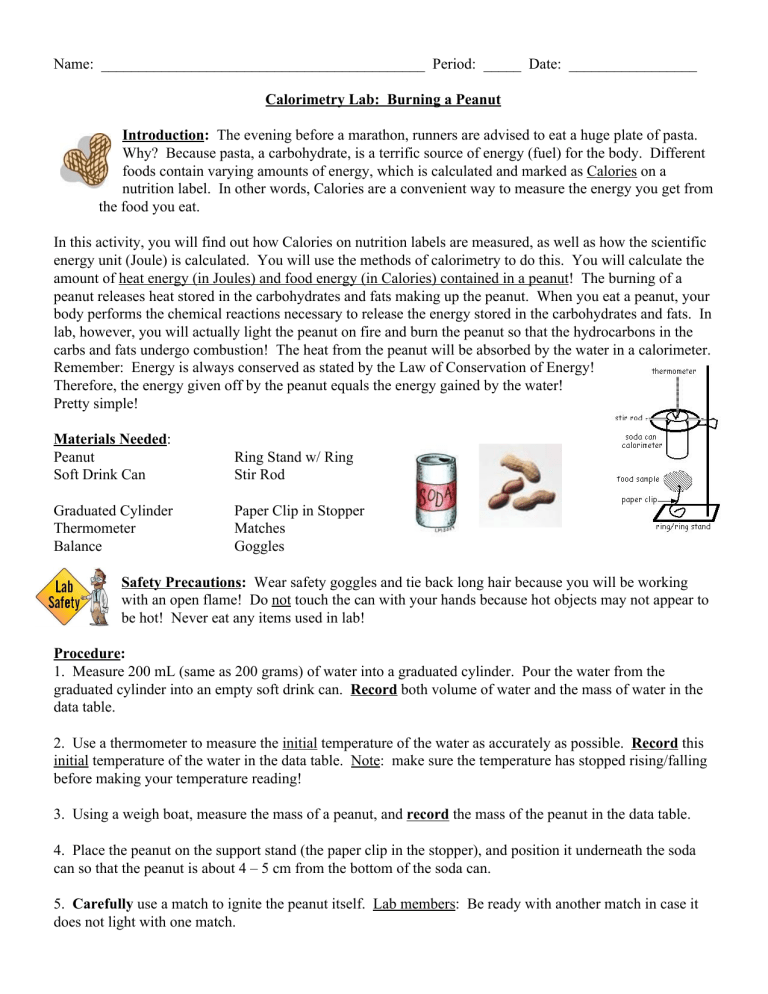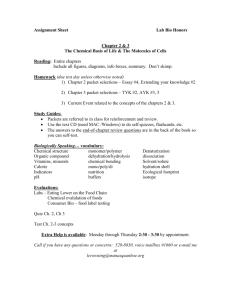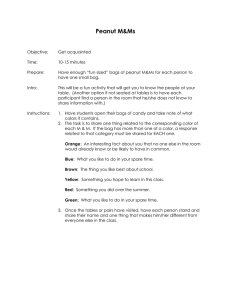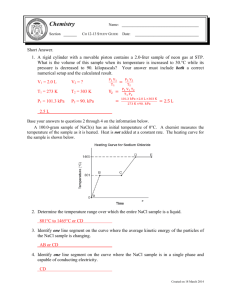
Name: ___________________________________________ Period: _____ Date: _________________ Calorimetry Lab: Burning a Peanut Introduction: The evening before a marathon, runners are advised to eat a huge plate of pasta. Why? Because pasta, a carbohydrate, is a terrific source of energy (fuel) for the body. Different foods contain varying amounts of energy, which is calculated and marked as Calories on a nutrition label. In other words, Calories are a convenient way to measure the energy you get from the food you eat. In this activity, you will find out how Calories on nutrition labels are measured, as well as how the scientific energy unit (Joule) is calculated. You will use the methods of calorimetry to do this. You will calculate the amount of heat energy (in Joules) and food energy (in Calories) contained in a peanut! The burning of a peanut releases heat stored in the carbohydrates and fats making up the peanut. When you eat a peanut, your body performs the chemical reactions necessary to release the energy stored in the carbohydrates and fats. In lab, however, you will actually light the peanut on fire and burn the peanut so that the hydrocarbons in the carbs and fats undergo combustion! The heat from the peanut will be absorbed by the water in a calorimeter. Remember: Energy is always conserved as stated by the Law of Conservation of Energy! Therefore, the energy given off by the peanut equals the energy gained by the water! Pretty simple! Materials Needed: Peanut Soft Drink Can Ring Stand w/ Ring Stir Rod Graduated Cylinder Thermometer Balance Paper Clip in Stopper Matches Goggles Safety Precautions: Wear safety goggles and tie back long hair because you will be working with an open flame! Do not touch the can with your hands because hot objects may not appear to be hot! Never eat any items used in lab! Procedure: 1. Measure 200 mL (same as 200 grams) of water into a graduated cylinder. Pour the water from the graduated cylinder into an empty soft drink can. Record both volume of water and the mass of water in the data table. 2. Use a thermometer to measure the initial temperature of the water as accurately as possible. Record this initial temperature of the water in the data table. Note: make sure the temperature has stopped rising/falling before making your temperature reading! 3. Using a weigh boat, measure the mass of a peanut, and record the mass of the peanut in the data table. 4. Place the peanut on the support stand (the paper clip in the stopper), and position it underneath the soda can so that the peanut is about 4 – 5 cm from the bottom of the soda can. 5. Carefully use a match to ignite the peanut itself. Lab members: Be ready with another match in case it does not light with one match. 6. AS SOON AS the peanut stops burning, carefully stir the water with the thermometer, and measure the final temperature of the water to the nearest °C. Remember to make sure the temperature has stopped rising before taking a reading. Record the final temperature of the water in the data table. 7. Allow the peanut residue (ashes) to cool, and then measure the mass of the peanut ash. Record this mass of peanut residue in the data table. Note: Do not set the black peanut residue on the balance! Use a weigh boat, and tare the balance so that the weigh boat is not included in the mass of the peanut residue. 8. Calculate the mass of the peanut that actually burned. Record this mass in the data table. Clean Up Checklist: € Place peanut ashes into the trashcan. € Place used matches in beaker labeled “Used Matches” in the front of the room. € Pour the water from the soda can down the sink drain. DO NOT throw the soda can away. Replace the soda can on the ring stand with stir rod. € Clean up around station (wipe down station and dry). € Wash your hands when clean up is complete. € Get teacher initials for clean up! Data Table: Measurement Mass of Peanut Before Burning (grams) Mass of Peanut Ash After Burning (grams) Mass of Peanut that Actually Burned (grams) Mass of Water (grams) Initial Temperature of Water °C Final Temperature of Water °C Conclusions/Analysis: 1. a) Was burning the peanut an exothermic or endothermic process? ______________________________ b) Was the water heating up an exothermic or endothermic process? _____________________________ 2. What type of chemical reaction occurred while burning the peanut? ______________________________ 3. The SI unit for heat energy is the _________________. Another commonly used heat energy unit is the __________________. The unit for food energy is the _________________. 4. What is the specific heat of water? ______________________ 5. The heat energy from the burning peanut was transferred to the ______________________. Thus, we assume the heat energy given off from the peanut equals the heat energy gained by the _________________. We know this because of the _______________________________________________________________. 6. Calculate how much heat (in joules) that the water absorbed from the burning peanut. 7. Convert joules to Calories. ___________ ___________ 8. Calculate the number of Calories per gram of the peanut burned in lab. ___________ Is this the experimental or accepted value? ________________ 9. Using the peanut can label, determine the Calories per gram of the peanuts. ___________ Is this the experimental or accepted value? ________________ 10. Compare your experimentally calculated Calories per gram with the accepted value of Calories per gram on the peanut can’s label. Using this information, calculate the percent error for your lab group. ___________ 11. Was all of the heat that was released by the burning peanut actually collected by the water in the calorimeter? Explain. 12. How can the experiment be improved to decrease the percent error? List two ways. a. b.



